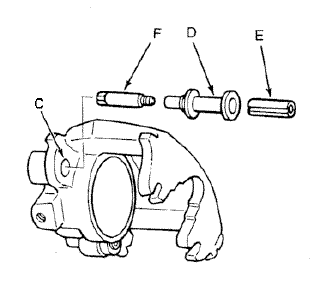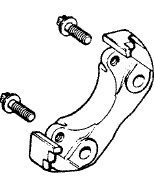Brake Maintenance |
|
| Background | |
| One of the secrets of going fast in an SRF is having a correctly operating braking system. This means optimum stopping power with minimum drag. This article will address both aspects. | |
| Preventative Maintenance | |
| Unlike
much of the hype around the original Sports Renault which claimed that “..all you
have to do is wax it!”, regular, preventative brake maintenance is essential in going
fast. Every Race Weekend The pistons (and you should only be using phenolic pistons for reasons I'll explain later) develop a light colored, flaky texture over time. This condition is exacerbated at tracks that have a high percentage of sustained braking (e.g. street circuits). You want to replace pistons that are starting to get very light colored (white) or are starting to break away. Also, it should go without saying that you bleed
the brakes for every event. I perform this task at the track (rather than at the
shop) to provide the freshest (driest) fluid for use during the weekend. Annually Here's one of the real “secrets”.
Referring to the picture of the caliper below, it is essential that you remove the
Teflon liner (“E”), the rubber grommet (“D”) and thoroughly clean the
mounting pin bore (“C”). The reason is that over time, rust and corrosion
build up inside the mounting pin bore and start clamping down on the mounting pin
(“F”). This has the effect of limiting the ability of the caliper to float
and will absolutely increase brake drag on the car. As I'm sure you understand,
brake drag is the same as less horsepower and is to be avoided. I use a 3/4"
steel wire “bottle brush” to clean out these bores. In addition, when
reassembling the calipers, I use a little grease to coat the bores to slow down the
corrosion. |
|
| Miscellaneous Brake Info | |
| Caliper
Pistons I only use the phenolic pistons. There are two reasons, 1) the phenolic pistons don't conduct heat as much as the steel pistons keeping brake fluid temperature lower, 2) the phenolic pistons weigh about 1 pound per wheel less than the steel pistons..and it is unsprung weight. The downside, of course, is that you need to replace the pistons on a fairly regular basis, but the cost is negligible compared to what we spend simply traveling to a race weekend. Below, you'll find the Chrysler part number for the rebuild kits which include the rubber o-ring and a phenolic piston. Brake Fluid Torque Brackets
It's important to be sure that the "ears" of the torque bracket are clean and free of rust to allow the pads to move easily. I wire brush the ears and coat them with oil. In addition, when mounting the torque bracket to the hub, be sure to use red Locktite (#271) on the bolts and torque to 74 foot-pounds. The socket required for these strange mounting bolts is a Snap-On #FLE140. By the way, the proper torque for the caliper mounting pins is 25-27 foot-pounds. Parts |
|
Rev. 2/21/98 |
|


